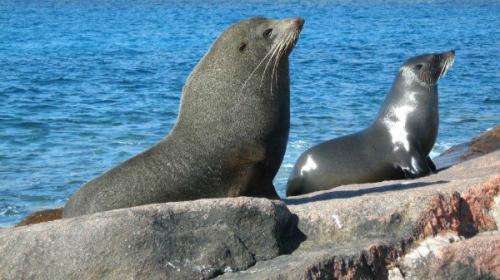Fur seal population bounces back while sea lions struggle

Studies of New Zealand fur seals (Arctocephalus forsteri) in Western Australia have revealed their populations are continuing to increase, though at much slower rates than a decade ago.
A recent survey found the marine mammal population is growing at a rate of one to two per cent a year, based on seal pup counts at 17 breeding colonies from the Recherche Archipelago, near Esperance, to Augusta.
Department of Parks and Wildlife research scientist Richard Campbell says the rate of growth is significantly less than that experienced from 1989 to 1999, when the population increased by 10 per cent a year.
He says the seals are also expanding their range, with the establishment of a breeding colony near Bunker Bay, a new haul-out area on Rottnest Island and the seals now hauling out occasionally as far north as Jurien Bay.
Dr Campbell says the reduced growth rate and increased range suggests the population has recovered from sealing practices in the 1800s to the extent it is again reaching its capacity.
"It looks as though the population is as large as it can sustain," Dr Campbell says.
Sea lion numbers falter
However, recent counting of Australian sea lion populations tells a different story.
While more difficult to count because of a long breeding season and differences in breeding times at individual colonies, Dr Campbell says Australian sea lion populations appear to be experiencing no growth and, in some cases, decline.
He says the species, classified as 'vulnerable', doesn't appear to have reached the critical mass to stage a population recovery in WA like the New Zealand fur seal.
He attributes the stagnant population growth to several reasons. Firstly, the Australian sea lion breeds every 17.5 months, compared to every 12 months for every other seal species.
Secondly, the females stay at the same colony they were born to breed, meaning there are no migrating sea lions to bolster a colony in decline.
Thirdly, individuals limit their foraging to a specific area, leaving them vulnerable to a decline in their local food source.
Lastly, they are more likely to come into contact with the fishing industry because of their tendency to forage on the sea bottom.
Dr Campbell says, while adaptations to rock lobster pots have helped prevent Australian sea lions from drowning in pots, it is too early to tell what effect this is having on helping the population to recover.
More information: "Changes in the abundance and distribution of the New Zealand fur seal (Arctocephalus forsteri) in Western Australia: are they approaching carrying capacity?" Australian Journal of Zoology 62(4) 261-267 dx.doi.org/10.1071/ZO14016
Journal information: Australian Journal of Zoology
Provided by Science Network WA















